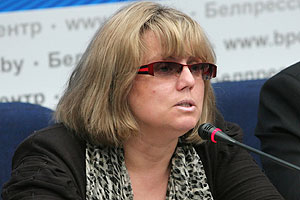Opinions & Interviews
Contribution of Belarusian, Russian scientists to world radiology praised

GORKI, 30 October (BelTA) – The research projects carried out by Belarusian and Russian scientists in the aftermath of the Chernobyl catastrophe have made a huge contribution to the world radiology. The opinion was voiced by Maria Germenchuk, Head of the National Center for Hydrometeorology, Radioactive Pollution Control, and Environmental Monitoring of the Belarusian Natural Resources and Environmental Protection Ministry, BelTA has learned. The official took part in the seminar held by the Parliamentary Assembly of the Union of Belarus and Russia in the Belarusian town of Gorki to discuss the Union State’s role in overcoming consequences of the Chernobyl catastrophe.
Maria Germenchuk said: “The Union State and joint programs aimed at overcoming consequences of the Chernobyl catastrophe give a unique opportunity for combining the scientific potential of Belarus and Russia to produce positive effects that cannot be achieved by individual countries.” The efforts have brought about a common environmental monitoring system that provides Belarus and Russia with precise information about the radiation situation in the two countries and in the area along the border. The system allows collecting up-to-date information about the radiation situation around hazardous installations and feeding the information to government agencies, mass media, and the nation. By sharing this information Belarus and Russia can analyze it and making correct management decisions.
The exchange of scientific data is another facet of the joint work. In particular, the sides have managed to create maps detailing radioactive pollution. It is a magnificent result secured thanks to the implementation of joint programs. The radioactive pollution atlas combines assessments of the radioactive situation in Belarus and Russia, allowing making decisions at the interstate level, in the transboundary and borderline context. Important projects have been implemented to study radioactive pollution in the Polesie radiological wildlife sanctuary. For the first time ever soil samples were taken with very small steps to produce extremely detailed maps of radioactive pollution of the territory.
“The results represent a huge contribution to the world radiology. They will allow perfecting radiation situation technologies for polluted areas and compiling databases for making decisions. It’s been 30 years since the Chernobyl catastrophe. We can analyze whether the radiation situation development forecasts have been justified and they have. It means that the decisions made on the basis of those forecasts were effective,” stressed Maria Germenchuk. In her opinion, the accomplishments secured in the years of scientific research of the Chernobyl catastrophe can now be converted into classic scientific knowledge such as guidelines, best practices, publications, maps, atlases and so on. “Because the strata of the knowledge acquired over the course of 30 years represents an invaluable contribution of Belarus, Russia, and certainly we have to remember Ukraine’s contribution,” noted the official.
According to the source, the next step of the program should be directed towards minimizing the consequences and making the transition from work in conditions of radiation pollution to conditions of existing radiation. All in all, the situation is now stable and no major changes of the radiation situation are likely to occur in the near future. Potential problems can certainly still exist but the environment is monitored and forecasts are made. The problem is still on the agenda but there is no threat right now.







 print version
print version make home page
make home page add to bookmarks
add to bookmarks

